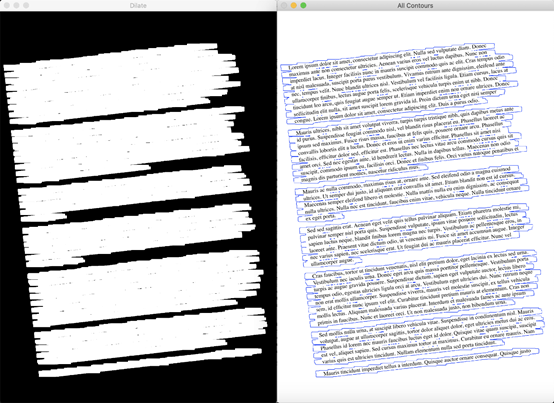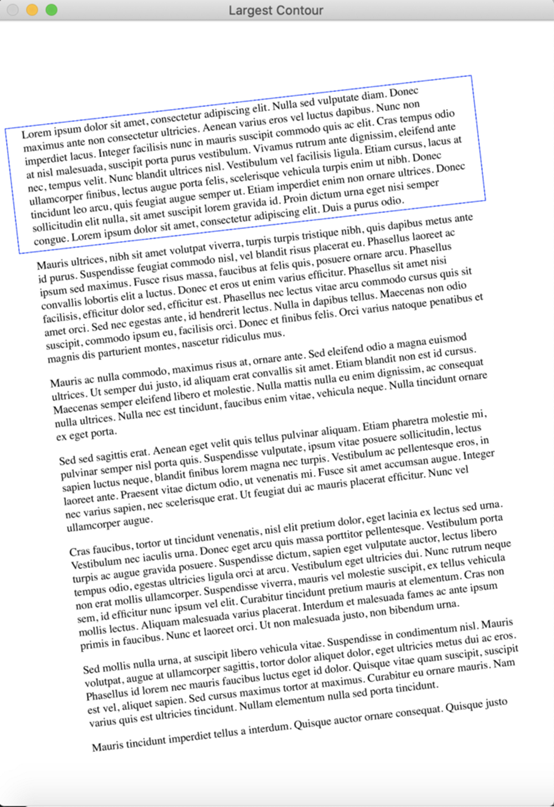如何使用OpenCV自动校正文本图像
点击上方“小白学视觉”,选择加"星标"或“置顶”
重磅干货,第一时间送达
今天,我们想与您分享解决图像偏移校正问题(拉直旋转图像)的简单解决方案。如果我们正在从歪斜图像中提取文本的内容,则必须以一种或另一种形式处理图像。从摄像机图片到扫描的文档-将清理后的图像馈送到OCR工具之前,去歪斜是图像预处理中的必要步骤。
让我们开始讨论Deskeweing算法的一般概念。我们的主要目标是将旋转的图像分成文本块,并确定它们的角度。为了让您详细了解我将使用的方法:
1. 照常-将图像转换为灰度。
2. 应用轻微的模糊以减少图像中的噪点。
3. 现在,我们的目标是找到带有文本的区域,即图像的文本块。为了使文本块检测更容易,我们将反转并最大化图像的颜色,这将通过阈值化来实现。因此,现在文本变为白色(恰好为255,255,255白色),而背景为黑色(同样为0,0,0黑色)。
4. 要查找文本块,我们需要合并该块的所有打印字符。我们通过膨胀(扩展白色像素)来实现。在X轴上使用较大的内核可以消除单词之间的所有空间,而在Y轴上使用较小的内核可以将彼此之间的一个块的行混合在一起,但保持文本块之间的较大间隔不变。
5. 现在,用最小面积矩形包围轮廓的简单轮廓检测将形成我们需要的所有文本块。
6. 确定倾斜角度的方法有很多种,但我们将坚持简单的方法-使用最大的文本块并使用其角度。
现在切换到python代码:
# Calculate skew angle of an imagedef getSkewAngle(cvImage) -> float:#Prep image, copy, convert to gray scale, blur, and thresholdnewImage = cvImage.copy()gray = cv2.cvtColor(newImage, cv2.COLOR_BGR2GRAY)blur = cv2.GaussianBlur(gray, (9, 9), 0)thresh = cv2.threshold(blur, 0, 255, cv2.THRESH_BINARY_INV +cv2.THRESH_OTSU)[1]#Apply dilate to merge text into meaningful lines/paragraphs.#Use larger kernel on X axis to merge characters into single line, cancellingout any spaces.#But use smaller kernel on Y axis to separate between different blocks of textkernel = cv2.getStructuringElement(cv2.MORPH_RECT, (30, 5))dilate = cv2.dilate(thresh, kernel, iterations=5)#Find all contourshierarchy = cv2.findContours(dilate, cv2.RETR_LIST,cv2.CHAIN_APPROX_SIMPLE)contours = sorted(contours, key = cv2.contourArea, reverse = True)#Find largest contour and surround in min area boxlargestContour = contours[0]minAreaRect= cv2.minAreaRect(largestContour)#Determine the angle. Convert it to the value that was originally used to obtainskewed imageangle = minAreaRect[-1]if angle < -45:angle = 90 + anglereturn -1.0 * angle
获得偏斜角后,我们只需要重新旋转图像即可:
# Rotate the image around its centerdef rotateImage(cvImage, angle: float):newImage = cvImage.copy()w) = newImage.shape[:2]center = (w // 2, h // 2)M= cv2.getRotationMatrix2D(center, angle, 1.0)newImage = cv2.warpAffine(newImage, M, (w, h), flags=cv2.INTER_CUBIC,borderMode=cv2.BORDER_REPLICATE)return newImage# Deskew imagedef deskew(cvImage):angle = getSkewAngle(cvImage)return rotateImage(cvImage, -1.0 * angle)



可视化步骤
其他案例可能需要更多的计算,而不仅仅是采取最大的方法,并且可以开始尝试一些其他策略。
1- 可以使用所有文本块的平均角度:
allContourAngles = [cv2.minAreaRect(c)[-1]for c in contours]angle = sum(allContourAngles) /len(allContourAngles)
2- 可以采用中间块的角度:
middleContour = contours[len(contours) //2]angle = cv2.minAreaRect(middleContour)[-1]
3- 可以尝试最大,最小和中间块的平均角度。
largestContour = contours[0]middleContour = contours[len(contours) //2]smallestContour = contours[-1]angle =sum([cv2.minAreaRect(largestContour)[-1], cv2.minAreaRect(middleContour)[-1],cv2.minAreaRect(smallestContour)[-1]]) / 3
那只是我们可以立即想到的一些替代方式。继续尝试,找出最适合您的情况的方法!
为了测试这种方法,我使用了一个新生成的带有Lorem Ipsum文本的PDF文件。本文档的首页以300 DPI分辨率(使用PDF文档时最常用的设置)呈现。之后,通过拍摄原始图像并在-10度到+10度范围内随机旋转来生成20个样本图像的测试数据集。然后,我将图像及其倾斜角度保存在一起。您可以在我的GitHub存储库中找到用于生成这些示例图像的所有代码,这里不再赘述。
测试结果的统计样本:
Item #0,with angle=1.77, calculated=1.77, difference=0.0%Item #1,with angle=-1.2, calculated=-1.19, difference=0.83%Item #2,with angle=8.92, calculated=8.92, difference=0.0%Item #3,with angle=8.68, calculated=8.68, difference=0.0%Item #4,with angle=4.83, calculated=4.82, difference=0.21%Item #5,with angle=4.41, calculated=4.4, difference=0.23%Item #6,with angle=-5.93, calculated=-5.91, difference=0.34%Item #7,with angle=-3.32, calculated=-3.33, difference=0.3%Item #8,with angle=6.53, calculated=6.54, difference=0.15%Item #9,with angle=-2.66, calculated=-2.65, difference=0.38%Item #10,with angle=-2.2, calculated=-2.19, difference=0.45%Item #11,with angle=-1.42, calculated=-1.4, difference=1.41%Item #12,with angle=-6.77, calculated=-6.77, difference=0.0%Item #13,with angle=-9.26, calculated=-9.25, difference=0.11%Item #14,with angle=4.36, calculated=4.35, difference=0.23%Item #15,with angle=5.49, calculated=5.48, difference=0.18%Item #16,with angle=-4.54, calculated=-4.55, difference=0.22%Item #17,with angle=-2.54, calculated=-2.54, difference=0.0%Item #18,with angle=4.65, calculated=4.66, difference=0.22%Item #19,with angle=-4.33, calculated=-4.32, difference=0.23%MinError: 0.0%MaxError: 1.41%Avg Error: 0.27%
这种方法效果很好,与真实的歪斜角度仅产生很小的偏差。对于人眼和OCR引擎而言,此类错误已不再明显。
交流群
欢迎加入公众号读者群一起和同行交流,目前有SLAM、三维视觉、传感器、自动驾驶、计算摄影、检测、分割、识别、医学影像、GAN、算法竞赛等微信群(以后会逐渐细分),请扫描下面微信号加群,备注:”昵称+学校/公司+研究方向“,例如:”张三 + 上海交大 + 视觉SLAM“。请按照格式备注,否则不予通过。添加成功后会根据研究方向邀请进入相关微信群。请勿在群内发送广告,否则会请出群,谢谢理解~

